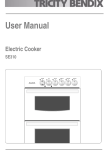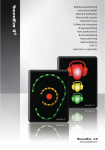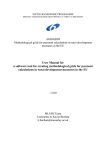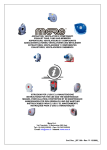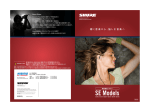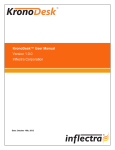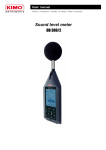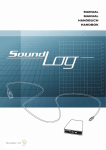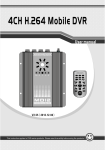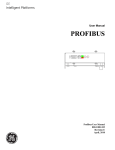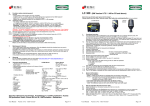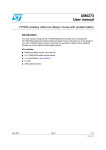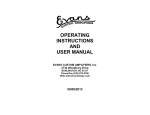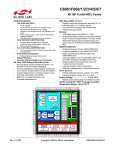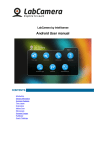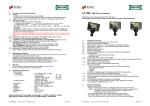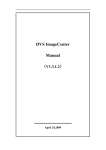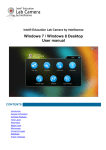Download SoundEar®3
Transcript
SoundEar 3 ® Manual – UK Model 300 Model 310 Model 320 TABLE OF CONTENTS Congratulations on your new SoundEar®3 Box Content 3 4 Before you start SoundEar®3 model 300 and 310 SoundEar®3 model 320 Mounting SoundEar®3 on wall · Model 300 or model 310 · Model 320 Set time Formatting the USB key 5 5 6 7 7 7 7 8 Touch display 9 Software Software installation Configuration of devices Navigating the software File · Live measurements · Open measurements · Import from USB · Save Settings Log/Settings · Device Info · Log Settings Display · Display Settings Light Settings · Standard/ Day · Night Settings Advanced Settings · Analog Output · Microphone Calibration SoundEar®3 User Manual About SoundEar®3 Factory Settings 11 11 12 13 17 17 17 19 20 20 20 21 22 22 23 23 24 25 25 27 30 30 30 Choosing alarm levels 31 Maintenance · Disinfection / cleaning Appliances for SoundEar 3 · SoundBuster Technical Specifications · SoundEar®3 31 31 32 32 32 33 Congratulations on your new S ound E ar ® 3 We are pleased that you selected one of our products to help you create a better auditive environment for yourself and others. This instruction manual provides information on how to take advantage of your product to the fullest. In order to fully understand the features and possibilities of SoundEar®3, we advice you to read this manual carefully before you start using your SoundEar®3. Please find the latest updates for software and the manual on our web site www.soundear.dk For any questions or comments, please contact at: [email protected] Yours sincerely, SoundEar A/S SE300 SoundEar®3 – manual SE320 SE310 R e t u r n t o Ta b l e o f C o n t e n t s Box Content Check package contents depending on the package purchased. 1 2 3 4 5 6 SoundEar®3 USB key with software External microphone 4 pole extension cable for calibration Power adaptor with EU, US og UK plug USB adaptor cable (A-plug or micro-B) R e t u r n t o Ta b l e o f C o n t e n t s SoundEar®3 – manual BEFOrE yOU STArT SOUNDEAr®3 – MODEL 300 AND 310 Power 24 VDC 3 4 5 Out 2 2 - GND 1 + Out 1 5 USB Log/ config. Analogue 0-10V/ Outputs 4-20 mA Power 5 VDC/ PC data SoundBuster Ext. mic. 24 VDC/150 mA Analog output for connection to an external system. SoundEar®3 – manual Export data Micro USB to from the power adaptor internal memory. or PC. Software configuration. SoundBuster is a relay used for controlling connected sound systems, lamps etc. Microphone input. R e t u R n t o ta b l e o f C o n t e n t s SoundBuster USB Log/ config. Power 5 VDC/ PC data 4 3 Out 1 Ext. mic. 5 GND 66 Out 2 SOUNDEAr®3 – MODEL 320 Analogue 0-10V/ Outputs 4-20 mA 2 - 1 + Power 24 VDC 24 VDC/150 mA Microphone input. SoundBuster is a relay used for controlling connected sound systems, lamps etc. R e t u R n t o ta b l e o f C o n t e n t s Micro USB to power adaptor or PC. Export data from the internal memory. Software configuration. Analog output for connection to an external system. SoundEar®3 – manual Mounting SoundEar®3 on wall When choosing a location for your SoundEar®3, please make sure to follow the instructions below: 1. Make sure not to cover the microphone at the bottom of the device. 2. Avoid placing SoundEar®3 close to sound absorbing materials. Directly on the wall: Model 300 or 310 Check if there is an available plug socket nearby. Fasten a screw (diameter 8-9mm.) to the wall 150-200 cm above the floor. Check if the cabinet is attached securely. If you are using a Vesa wall mount, please consult the included user manual. Model 320 Loosen the screw to remove the wall mount. Fasten the wall mount to the wall with 4 screws. Hang SoundEar®3-320 onto the wall mount and fasten it with the screw. Set time SoundEar®3 has a built-in time and date function that will set automatically when you connect the device to your PC. SoundEar®3 – manual R e t u r n t o Ta b l e o f C o n t e n t s Formatting the USB key The USB key included is formatted in the format called ”FAT32”. If you wish to use an alternative USB key with a larger memory, it is important that it has the same format. Please follow the steps below to format your USB key. Note! Remember to export any files you may have on your USB key before formatting, as the formatting will override any existing files. 1. Connect the USB key to your PC. 2.Right-click on the USB drive. 3. Select “Format” from the drop-down menu. 4. Select “Fat 32” under File System. 4. Select “Fat 32” under File System. 5. Check the box “Express formatting” 5. Check the box “Express formatting” 6. Click “Start” 6. Click “Start” 7. The USB key is now ready for use. R e t u r n t o Ta b l e o f C o n t e n t s SoundEar®3 – manual Touch display Located on the front of SoundEar®3 you will find a touch display from which you can control the device manually. The functions of the touch display include setting alarm levels, time, noise level, temperature, Leq15 and on/off function for the mini display. Use the horizontal arrow heads to navigate between the different options. Use the vertical arrow heads to set the alarm level. Please note! To lock the touch display, please go to ”Display Settings” in the software. Set the alarm level. Navigate between the different options. Touch display options Clock – See the time in the mini display. The time settings will sync automatically when you connect SoundEar®3 to your PC for the first time. °C – Shows the room temperature. AL – Set alarm level. Set the visual alarm level. With the horizontal arrow heads select the ”AL” function. Place a finger on either of the vertival arrow heads to set SoundEar®3 – manual R e t u r n t o Ta b l e o f C o n t e n t s the alarm level. Hold your finger down until the desired alrarm level is reached. Example: If the alarm is set to 80 dB, the red light will be lit when the noise level reaches 80 dB. As a standard setting, the yellow light will be lit 5 dB before the alarm level is reached, in this case at 75 dB. These standard settings can be changed under ”Light Settings” in the software. Please note! Changing the alarm level on the touch display will override any special settings made in “Light Settings” in the software. Leq 15 – Shows the average noise level in the past 15 minutes. dB.A S – Shows the current noise level in dB (A) Slow. 10 10 OFF – Turn off the mini display. When turned off, a small red light will be lit to indicate that the device is turned on. R e t u r n t o Ta b l e o f C o n t e n t s SoundEar®3 – manual Software Software installation Please find the software on the included USB key. Insert the USB key in your PC’s USB port. A pop-up window should automatically open from which you can install the software. 11 If the pop-up window does not appear, please find the installation programme on the USB drive. Double-click on the SoundEar®3 installation programme to begin the software installation. SoundEar®3 – manual R e t u r n t o Ta b l e o f C o n t e n t s Select language to be used for the software installation. Click OK. Follow the instructions and complete the installation. 12 Configuration of devices Configuration of SoundEar®3 can be performed in 2 different ways. The first option is to have SoundEar®3 connected to your PC while performing the configuration (Direct configuration). The second option is to save the settings on a USB key (Offline configuration). Direct configuration: Connect your SoundEar®3 to your PC. When using this method it is important to click ”Configure” whenever you have made changes in your settings. This way, your settings will be exported directly from your PC to your SoundEar®3. The next chapter is based on a direct configuration. Offline configuration: Transfer your settings from the software to your SoundEar®3 via the included USB. Insert the included USB key in your PC’s USB port. Perform the configuration and click ”Save Settings” in the menu to the left. Afterwards, you can save your settings on your computer or on the USB key. For more details, please look up ”Save Settings”. R e t u r n t o Ta b l e o f C o n t e n t s SoundEar®3 – manual Navigating the software Live Measurement Window Hold the cursor over the graph to view measurement and time. 13 Select what values you want the graph to show. View LAeq max, LAeq min, LAeq mean and LAeq peak max values for the entire measuring time. SoundEar®3 – manual R e t u r n t o Ta b l e o f C o n t e n t s Show Marker Start by checking the box ”Show marker”. A red left-marker and a blue right-marker will appear. 14 R e t u r n t o Ta b l e o f C o n t e n t s SoundEar®3 – manual 15 Double-click in either the red or blue time box. Type the time you want to view. Note! Use semicolon between hours and minutes. The graph is updated. Alternatively, use the cursor to pull the markers into the desired time position. Leq-15, Leq-30 and Leq-60 indicate the average noise level in the past 15, 30 or 60 minutes, based on the time position of the red marker. SoundEar®3 – manual The values shown (LAeq-min, LAeqmax, LAeq-gennem and LCpeak) represent the measurements of the time interval between the red and the blue marker. Shows time and noise level. R e t u r n t o Ta b l e o f C o n t e n t s Zoom function When data is shown on the graph it is possible to zoom in on a specific area. 16 Current measurement. • Position your cursor anywhere on the graph. • Left-click and use the cursor to pull the box, pulling towards the right. • Release the cursor when the wanted area is selected. • View the magnified area. R e t u r n t o Ta b l e o f C o n t e n t s SoundEar®3 – manual Selected area. 17 How to exit the zoom function: 1. Position your cursor anywhere on the graph. 2. Left-click and use the cursor to pull the box, pulling towards the left until the box is visible again. File Live measurements Connect your SoundEar®3 directly to your PC to view all your measurements. All data will be saved on your PC’s C-drive under ”SoundEar3 Data”. Open measurements SoundEar®3 stores all live measurements on the C-drive in the folder called ”SoundEar3 Data” automatically. This is also where data is stored when you export data from SoundEar®3 to your PC via a USB key. All files are saved in a CSV-format that can be exported to Excel. Live measurements will be saved as ”PC” and imported data from SoundEar®3’s internal memory will be saved as ”Internal”. SoundEar®3 – manual R e t u r n t o Ta b l e o f C o n t e n t s The names for the log files consist of 3 elements: 1. Name of device 2. Date 3. ”PC” for live measurements and ”Internal” for imported data from USB. Example of a live measurement: • Office1-11-03-2015-PC Example of an imported measurement: • Office1-09-03-2015-internal Click ”SoundEar3 Data” to update the folder in the software. 18 To edit, re-name or save the log files in an alternative folder, go to ”SoundEar Data” on the C-drive. Click ”Open in Explorer” to take a short cut to the ”SoundEar Data” folder. R e t u r n t o Ta b l e o f C o n t e n t s SoundEar®3 – manual import from usB 1. Connect the USB key to your SoundEer®3. The words ”USB” followed by ”COPy” will appear in the mini display. The import will now begin. Counting from 0-100 the mini displays shows the progress of the export to USB. when the mini display shows ”100” the export is complete. 2. remove the USB key from the SoundEar®3 and insert into your PC. 3. Open the software and click ”Import from USB”. 4. Select the file you want to import. 1 5. The software now converts the ear-file to a CSV-file and saves it in the internal library. SoundEar®3 – manual R e t u R n t o ta b l e o f C o n t e n t s Save Settings Transfer your settings from the software to your SoundEar®3 via the included USB. This makes it easy to apply the same configuration to several devices. Change the settings: • Log Settings • Display Settings • Standard/ Night 1. Click “Save Settings” to save your changes. 2. Save the changes on your PC or directly to the included USB key. Export new settings from USB to SoundEar®3 1. Disconnect the power from SoundEar®3. 2. Insert the USB key with your new configuration. 3.Re-connect the power to SoundEar®3. 4. The word ”USB” will appear in the mini display. The diodes will turn off for 3 seconds. When the mini display shows ”100”, the configuration is exported to SoundEar®3 and your new settings are ready for use. Please note! Changing the settings on the touch display will override your software settings, unless you lock the mini display in ”Display Settings”. Log/Settings Device Info 20 • • • Version: Shows the firmware version installed on your SoundEar®3. Name: Name your device. Log files will be named after the name of their device. Location: Type in the location of the device. Note! To name a device, it must be connected directly to your PC. Any name changes cannot be imported to SoundEar®3 via the USB key. R e t u r n t o Ta b l e o f C o n t e n t s Save your settings by clicking ”Configure” in the bottom right corner. SoundEar®3 – manual Log Settings SoundEar®3 has an internal 16MB memory. “Logging time” indicates how much time the device can log before the internal memory is full. Select 1 or more types of measurements by checking the boxes to the left. The logging time will change relative to the type and amount of measurements you choose to log. Note! Remember to export the measurements within the given logging time. If the time limit is exceeded, the device will override the oldest files automatically. 21 If you need a larger memory, you can log externally on a 8GB USB key. Save your settings by clicking ”Configure” in the bottom right corner. Note! This way, all data will be logged on the USB key only. SoundEar®3 – manual R e t u r n t o Ta b l e o f C o n t e n t s Display Display Settings 22 The digital mini display can be set to show the following informations: • Db (A) slow • LAeq15 • Alarm level • Temperature • Time (clock) • Off (turn off the mini display) Save your settings by clicking ”Configure” in the bottom right corner. If you wish to lock your software settings, so SoundEar®3 cannot be operated manually via the touch display, simply check the box ”Locked display”. R e t u r n t o Ta b l e o f C o n t e n t s SoundEar®3 – manual Light Settings Standard / Day In light settings you have the ability to make individual settings for each of the 3 alarm colours: 23 • Lit or flashing alarm (Lit/Flashing) • dB interval, choose between 30 - 130 dB • Duration of noise before the alam is activated (Only for dB(A) or dB(C)) • Duration of the visual alarm. In this example, it is 0,5 seconds. Choose between these measurent types: • dB(A) – A weighted value equivalent to human hearing. • dB(C) - A weighted value that is equally high across the entire frequency spectrum. • LAeq15 – Average noise level over the past 15 minutes i A weighted values. • LAeq30 - Average noise level over the past 30 minutes i A weighted values. • LAeq60 - Average noise level over the past 60 minutes i A weighted values. Note! Changing settings manually on the touch display will override the light settings made in the software. To avoid this, simply lock the touch display in “Display settings”. To save your settings, click ”Configure” in the bottom right corner. SoundEar®3 – manual R e t u r n t o Ta b l e o f C o n t e n t s Night Settings In Night Settings you can create special light and alarm settings that stay activated during a specific period of time. This can be useful in hospitals where a minimum of light is needed to avoid disturbing the patients’ sleep at night. Check the box and select time interval. 24 Set the visual alarm (see ”Light Settings”). We recommend setting the dB level relatively high, e. g. 60 dB, to avoid the visual alarm from constantly being lit. Note! During night mode it is not possible to change alarm settings manually via the touch display. R e t u r n t o Ta b l e o f C o n t e n t s Save your settings by clicking ”Configure” in the bottom right corner. SoundEar®3 – manual Advanced Settings Analog Output The analog outputs enable you to connect SoundEar®3 to Building Management Systems ( BMS ) or communicate with other devices that are compatible with analog outputs. Note! SoundEar®3 must be provided with 24VDC through the screw terminal for the analog outputs to function. Please find an overview and description of the various outputs on the back of the device. Note! The 2 analog outputs have common ground connection. Power 24 VDC USB Log/ config. Analogue 0-10V/ Outputs 4-20 mA Power 5 VDC/ PC data SoundBuster Ext. mic. 24 VDC/150 mA Ext. mic. SoundBuster Power 5 VDC/ PC data USB Log/ config. 5 4 3 GND 5 Out 1 4 SE 320 Out 2 3 GND 2 - Out 2 1 + Out 1 SE 300 and 310 Analogue 0-10V/ Outputs 4-20 mA 2 - 1 + Power 24 VDC 24 VDC/150 mA 25 You can record up to two indivual measurements simultaneously, one per analog output. In the drop-down menu you can choose between 7 different values for each output. SoundEar®3 – manual R e t u r n t o Ta b l e o f C o n t e n t s 26 Choose analog output format, either 0-10V or 4-20mA. Set dynamic area, e. g. 30-120 dB. Save your settings by clicking ”Configure” in the bottom right corner. R e t u r n t o Ta b l e o f C o n t e n t s SoundEar®3 – manual miCrophone CaliBration To calibrate the SoundEar®3 microphone, you will need a calibrator. you can use any standard calibrators on the market with a microphone input of 1⁄2 inch. note! For proper calibration, only use the included 4-pole extension cable. If calibrating more than 1 microphone, disconnect the extension cable from the SoundEar®3 and reinsert it between each calibration. The specific microphone ID and last date of calibration is displayed in the upper left corner of the microphone. we recommend that the microphone is calibrated once a year, or as needed. Connect SoundEar®3 to your PC with a mini USB cable and remove the external microphone. SoundEar®3 – manual R e t u R n t o ta b l e o f C o n t e n t s Connect the microphone to the 4-pole extension cable and insert the cable into SoundEar®3’s microphone input. Set the calibrator to 94 dB and connect the microphone. Under “Measurements” you can view what the microphone detects. Depending on time since last calibration, the measurement should be approx. 94 dB. Click “Perform Calibration” in the bottom right corner. R e t u R n t o ta b l e o f C o n t e n t s SoundEar®3 – manual The calibration takes a short moment. A new pop-up window will tell you when the calibration is complete. when the calibration is complete, connect the microphone to SoundEar®3. SoundEar®3 is now ready for use. SoundEar®3 – manual R e t u R n t o ta b l e o f C o n t e n t s SoundEar®3 User Manual The online library allows you to access the latest updated versions of the user manual at any time. To access, simply click on ”SoundEar®3 User Manual” in the menu. About SoundEar®3 View what version of the SoundEar®3 software is installed on your PC. Click “Software update” to update to the latest version. You will be linked to our web site where you can access the latest versions. 30 Factory Settings To reset SoundEar®3 to factory settings, please use the settings below: Log setting: dB(A) Slow Light settings Green: 30 dB - 120 dB Yellow: 75 dB -120 dB Red: 80 dB -120 dB All measurements are shown as dB (A) Slow. Night Settings Green: 60 dB - 120 dB Yellow: 60 dB -120 dB Red: 60 dB -120 dB Night settings are not part of the standard settings. To activate, check the ”Night Settings” box. Advanced settings Output 1: dB(A) slow Output 2: dB (C ) Fast Output Type: 0-10 V Min output: 30 dB Max output: 120 dB R e t u r n t o Ta b l e o f C o n t e n t s SoundEar®3 – manual Choosing alarm levels We recommend the settings below: Auditive EnvironmentNoise limit in dB Exam - No disruptive noise - Intense concentration 35 - 45 dB Operating rooms, Neonatal Departments 35 - 45 dB Educational, schools 50 - 60 dB Open-plan offices, call centers 55 - 65 dB Industry without noisy machines Storage, assembly and laboratory work 60 - 70 dB Day care 70 - 80 dB Factories with noisy machines 75 - 85 dB 31 Concerts etc., rehearsal rooms, music schools (shorter stays) 92 - 105 dB Maintenance To ensure correct and precise performance of SoundEar®3, repairs and service should be carried out by a trained technician. After any reparirs or service, a functionality check must be performed before using SoundEar®3 again. Disinfection / cleaning SoundEar®3 consists partly of materials that cannot tolerate certain substances used in surface disinfectants. Disinfection by wiping • Firstly, remove dirt and grime from the surface using a damp disposable cloth. • Then disinfect the surface with alcohol wipes, followed by dry cloth. SoundEar®3 – manual R e t u r n t o Ta b l e o f C o n t e n t s Appliances for SoundEar®3 SoundBuster SoundBuster is a relay used for controlling connected sound systems, lamps etc. Sound Buster connects or disconnects the power when the noise limit set in SoundEar®3 is exceeded. Download product sheet here. 32 Technical Specifications SoundEar Software Operative system: Windows XP SP3, Windows Vista, Windows 7, Windows 8 Harddisk: 100 Mbytes fri RAM: 512MB RAM USB port: 1 x USB 2.0 port CPU: 1.5GHz AMD/Intel processor We recommend using a screen measuring minimum 1366x768. R e t u r n t o Ta b l e o f C o n t e n t s SoundEar®3 – manual SoundEar®3 SE 300 SE 310 Frequency Range: Measuring Level Range: Accuracy: Frequency Weighting: Time Weighting: Dynamic Range RMS: Light managing: Alarm settings: Alarm trigger display: 2 x Outputs (1 for dB A + 1 for dB C): 2 x USB ports: Display Data: Power Supply: Microphone: Mass Storage (Internal memory): Real Time Clock: Mechanical Features: Standards: SoundEar®3 – manual SE 320 20 Hz – 20kHz 30 dB – 120 dB +/- 0.5 dB dB(A) and dB(C) filters Slow (1S) & Fast (125mS) 90dB and Peak detection Full configurability through SoundEar software, including night setting 30-120 dB 1 sec – 5 min Either 0-10V or 4-20mA outputs Micro USB (Power & PC), USB OTG (Log, config) dB(A) Slow, Leq(A)15, Alarm settings, Temp, Clock 5VDC (micro USB) / 24VDC (screw terminal), Current consumption: max 2.5W. 20 Hz – 20 KHz 16MB (128MBit) (5-90 days log time, depending on log settings) High-precision type with battery backup (CR2032). Cabinet: Shockproof acrylic Measurements: length: 265 mm, width: 205 mm, height: 46 mm Weight: 1.5 kg IEC61672-2-2002. Type 2, ANSI S1,4 Type 260601-1: Medical electrical equipment - Part 1: General requirements for basic safety and essential performance. 60601-1-2: Medical electrical equipment - Part 1-2: General requirements for basic safety and essential performance R e t u r n t o Ta b l e o f C o n t e n t s 33 UK: The crossed-out wheeled bin means that within the European Union the product must be taken to separate collection at the product end of its life. This applies not only to your device but also to any enhancements marked with this symbol. Do not dispose of these products as unsorted municipal waste.


































